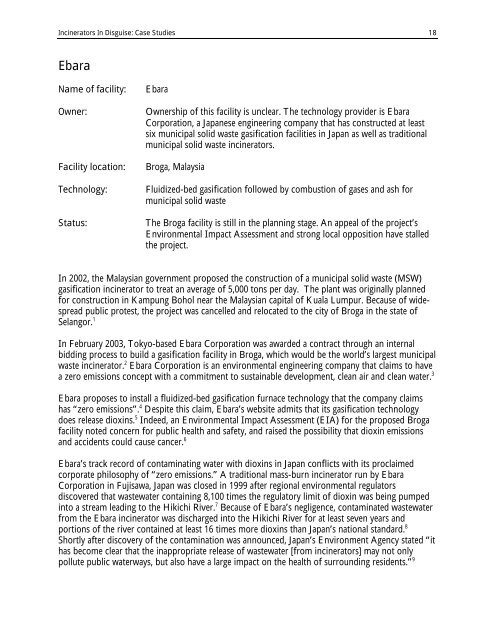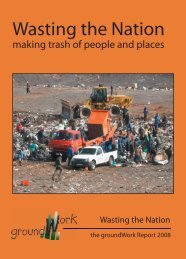Incinerators in Disguise - GAIA
Incinerators in Disguise - GAIA
Incinerators in Disguise - GAIA
You also want an ePaper? Increase the reach of your titles
YUMPU automatically turns print PDFs into web optimized ePapers that Google loves.
<strong>Inc<strong>in</strong>erators</strong> In <strong>Disguise</strong>: Case Studies 18<br />
Ebara<br />
Name of facility: Ebara<br />
Owner: Ownership of this facility is unclear. The technology provider is Ebara<br />
Corporation, a Japanese eng<strong>in</strong>eer<strong>in</strong>g company that has constructed at least<br />
six municipal solid waste gasification facilities <strong>in</strong> Japan as well as traditional<br />
municipal solid waste <strong>in</strong>c<strong>in</strong>erators.<br />
Facility location: Broga, Malaysia<br />
Technology: Fluidized-bed gasification followed by combustion of gases and ash for<br />
municipal solid waste<br />
Status: The Broga facility is still <strong>in</strong> the plann<strong>in</strong>g stage. An appeal of the project’s<br />
Environmental Impact Assessment and strong local opposition have stalled<br />
the project.<br />
In 2002, the Malaysian government proposed the construction of a municipal solid waste (MSW)<br />
gasification <strong>in</strong>c<strong>in</strong>erator to treat an average of 5,000 tons per day. The plant was orig<strong>in</strong>ally planned<br />
for construction <strong>in</strong> Kampung Bohol near the Malaysian capital of Kuala Lumpur. Because of widespread<br />
public protest, the project was cancelled and relocated to the city of Broga <strong>in</strong> the state of<br />
Selangor. 1<br />
In February 2003, Tokyo-based Ebara Corporation was awarded a contract through an <strong>in</strong>ternal<br />
bidd<strong>in</strong>g process to build a gasification facility <strong>in</strong> Broga, which would be the world’s largest municipal<br />
waste <strong>in</strong>c<strong>in</strong>erator. 2 Ebara Corporation is an environmental eng<strong>in</strong>eer<strong>in</strong>g company that claims to have<br />
a zero emissions concept with a commitment to susta<strong>in</strong>able development, clean air and clean water. 3<br />
Ebara proposes to <strong>in</strong>stall a fluidized-bed gasification furnace technology that the company claims<br />
has “zero emissions”. 4 Despite this claim, Ebara’s website admits that its gasification technology<br />
does release diox<strong>in</strong>s. 5 Indeed, an Environmental Impact Assessment (EIA) for the proposed Broga<br />
facility noted concern for public health and safety, and raised the possibility that diox<strong>in</strong> emissions<br />
and accidents could cause cancer. 6<br />
Ebara’s track record of contam<strong>in</strong>at<strong>in</strong>g water with diox<strong>in</strong>s <strong>in</strong> Japan conflicts with its proclaimed<br />
corporate philosophy of “zero emissions.” A traditional mass-burn <strong>in</strong>c<strong>in</strong>erator run by Ebara<br />
Corporation <strong>in</strong> Fujisawa, Japan was closed <strong>in</strong> 1999 after regional environmental regulators<br />
discovered that wastewater conta<strong>in</strong><strong>in</strong>g 8,100 times the regulatory limit of diox<strong>in</strong> was be<strong>in</strong>g pumped<br />
<strong>in</strong>to a stream lead<strong>in</strong>g to the Hikichi River. 7 Because of Ebara’s negligence, contam<strong>in</strong>ated wastewater<br />
from the Ebara <strong>in</strong>c<strong>in</strong>erator was discharged <strong>in</strong>to the Hikichi River for at least seven years and<br />
portions of the river conta<strong>in</strong>ed at least 16 times more diox<strong>in</strong>s than Japan’s national standard. 8<br />
Shortly after discovery of the contam<strong>in</strong>ation was announced, Japan’s Environment Agency stated “it<br />
has become clear that the <strong>in</strong>appropriate release of wastewater [from <strong>in</strong>c<strong>in</strong>erators] may not only<br />
pollute public waterways, but also have a large impact on the health of surround<strong>in</strong>g residents.” 9

















